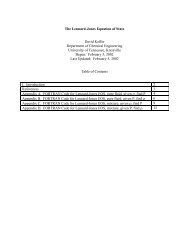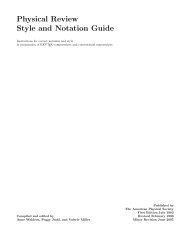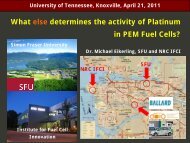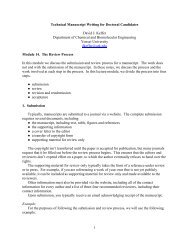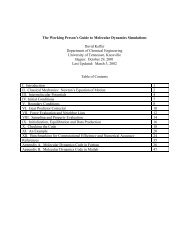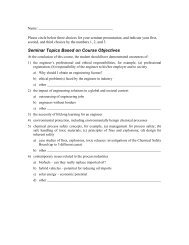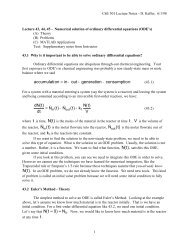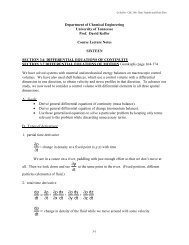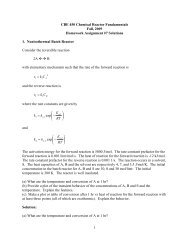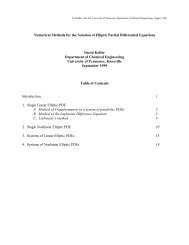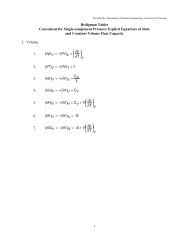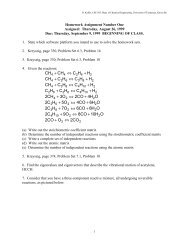A Statistical Mechanical Derivation of the van der Waals Equation of ...
A Statistical Mechanical Derivation of the van der Waals Equation of ...
A Statistical Mechanical Derivation of the van der Waals Equation of ...
Create successful ePaper yourself
Turn your PDF publications into a flip-book with our unique Google optimized e-Paper software.
⎛ ∂Em<br />
⎞<br />
⎜ ⎟<br />
⎝ ∂T<br />
⎠<br />
p<br />
= C<br />
V<br />
⎛ ∂p<br />
⎞<br />
+ T⎜<br />
⎟<br />
⎝ ∂T<br />
⎠<br />
Vm<br />
⎛ ∂Vm<br />
⎞<br />
⎜ ⎟<br />
⎝ ∂T<br />
⎠<br />
p<br />
⎛ ∂Vm<br />
⎞<br />
− p⎜<br />
⎟<br />
⎝ ∂T<br />
⎠<br />
p<br />
(20)<br />
Substituting equation (20) into equation (19) yields<br />
C<br />
p<br />
⎛ ∂p<br />
⎞ ⎛ ∂Vm<br />
⎞ 3<br />
1<br />
= CV<br />
+ T⎜<br />
⎟ ⎜ ⎟ = k<br />
B<br />
+ k<br />
B<br />
(21)<br />
2<br />
⎝ ∂T<br />
⎠V<br />
⎝ ∂T<br />
⎠ p<br />
2<br />
a( Vm<br />
− b)<br />
m<br />
1−<br />
2<br />
k TV<br />
B<br />
3<br />
m<br />
The constant-pressure heat capacity is a function <strong>of</strong> temperature and molar volume.<br />
Now let’s look at vapor-liquid equilibrium. The internal energy <strong>of</strong> vaporization is<br />
∆E<br />
m<br />
= E<br />
V<br />
m<br />
− E<br />
L<br />
m<br />
⎛ 1<br />
= a⎜<br />
L<br />
⎝Vm<br />
1<br />
−<br />
V<br />
V<br />
m<br />
⎞<br />
⎟<br />
⎠<br />
(22)<br />
The enthalpy <strong>of</strong> vaporization is<br />
∆H<br />
m<br />
= H<br />
V<br />
m<br />
− H<br />
L<br />
m<br />
= ∆E<br />
m<br />
+<br />
p∆V<br />
m<br />
⎛ 1<br />
= a⎜<br />
⎝V<br />
L<br />
m<br />
1<br />
−<br />
V<br />
V<br />
m<br />
⎞<br />
⎟<br />
+<br />
⎠<br />
p∆<br />
V L<br />
( V −V<br />
)<br />
m<br />
m<br />
(23)<br />
The entropy <strong>of</strong> vaporization is<br />
V<br />
V L<br />
⎛V<br />
⎞<br />
m<br />
− b<br />
∆S<br />
= − = ⎜ ⎟<br />
m<br />
S<br />
m<br />
S<br />
m<br />
k<br />
B<br />
ln L<br />
(24)<br />
⎝ Vm<br />
− b ⎠<br />
The molecular Gibbs free energy <strong>of</strong> vaporization is<br />
∆G<br />
m<br />
= G<br />
V<br />
m<br />
− G<br />
L<br />
m<br />
= k<br />
B<br />
L<br />
V<br />
L<br />
⎡ ⎛ V ⎞<br />
⎤ ⎛ ⎞<br />
m<br />
− b Vm<br />
Vm<br />
1 1<br />
T ⎢ln ⎜<br />
⎟ + − ⎥ + 2a<br />
⎜ −<br />
⎟ (25)<br />
V<br />
V<br />
L<br />
L V<br />
⎢⎣<br />
⎝Vm<br />
− b ⎠ Vm<br />
− b Vm<br />
− b⎥⎦<br />
⎝Vm<br />
Vm<br />
⎠<br />
Since <strong>the</strong> molecular Gibbs free energy <strong>of</strong> vaporization is zero at equilibrium, this gives a<br />
condition for vapor-liquid equilibrium, namely,<br />
L<br />
V<br />
L<br />
⎡ ⎛V<br />
⎞<br />
⎤ ⎛ 1 1 ⎞<br />
m<br />
− b Vm<br />
Vm<br />
k ⎢ln ⎜ ⎟ + − ⎥ + 2 ⎜ ⎟<br />
BT<br />
a<br />
−<br />
= 0<br />
(26)<br />
V<br />
V<br />
L<br />
L V<br />
⎢⎣<br />
⎝Vm<br />
− b ⎠ Vm<br />
− b Vm<br />
− b⎥⎦<br />
⎝Vm<br />
Vm<br />
⎠<br />
The chemical potentials should also be equal at equilibrium<br />
4



